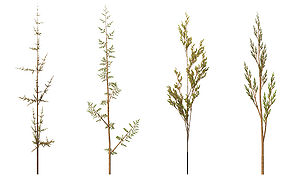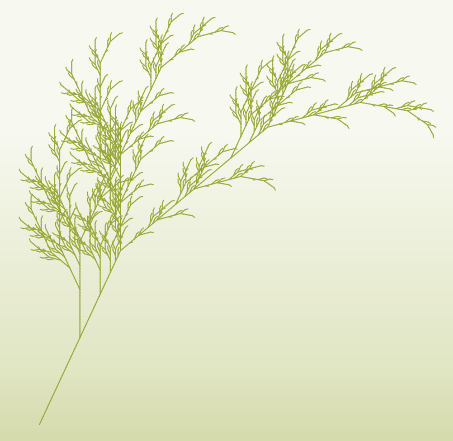
Simulated growth of plants
Encyclopedia
The simulated growth of plants is a significant task in of systems biology
and mathematical biology
, which seeks to reproduce plant morphology
with computer software.
Electronic trees (e-trees) usually use L-system
s to simulate growth. L-systems are very important in the field of complexity science and A-life.
A universally accepted system for describing changes in plant morphology at the cellular or modular level has yet to be devised.
The most widely implemented tree-generating algorithms are described in the papers "Creation and Rendering of Realistic Trees", and Real-Time Tree Rendering
 The realistic modeling of plant growth is of high value to biology, but also for computer games.
The realistic modeling of plant growth is of high value to biology, but also for computer games.
(1925–1989) worked with yeast
and filamentous fungi and studied the growth patterns of various types of algae, such as the blue/green bacteria Anabaena catenula
. Originally the L-systems were devised to provide a formal description of the development of such simple multicellular organisms, and to illustrate the neighbourhood relationships between plant cells. Later on, this system was extended to describe higher plants and complex branching structures.
Central to L-systems, is the notion of rewriting, where the basic idea is to define complex objects by successively replacing parts of a simple object using a set of rewriting rules or productions. The rewriting can be carried out recursively. L-Systems are also closely related to Koch curves.

is to build virtual/environments with as many parameters as computationally feasible, thereby, not only simulating the growth of the plant, but also the environment it is growing within, and, in fact, whole ecosystems.
Changes in resource availability influence plant growth, which in turn results in a change of resource availability. Powerful models and powerful hardware will be necessary to effectively simulate these recursive
interactions of recursive structures.
see Comparison of tree generators and A Survey of Modeling and Rendering Trees
Systems biology
Systems biology is a term used to describe a number of trends in bioscience research, and a movement which draws on those trends. Proponents describe systems biology as a biology-based inter-disciplinary study field that focuses on complex interactions in biological systems, claiming that it uses...
and mathematical biology
Mathematical biology
Mathematical and theoretical biology is an interdisciplinary scientific research field with a range of applications in biology, medicine and biotechnology...
, which seeks to reproduce plant morphology
Plant morphology
Plant morphology or phytomorphology is the study of the physical form and external structure of plants. This is usually considered distinct from plant anatomy, which is the study of the internal structure of plants, especially at the microscopic level...
with computer software.
Electronic trees (e-trees) usually use L-system
L-system
An L-system or Lindenmayer system is a parallel rewriting system, namely a variant of a formal grammar, most famously used to model the growth processes of plant development, but also able to model the morphology of a variety of organisms...
s to simulate growth. L-systems are very important in the field of complexity science and A-life.
A universally accepted system for describing changes in plant morphology at the cellular or modular level has yet to be devised.
The most widely implemented tree-generating algorithms are described in the papers "Creation and Rendering of Realistic Trees", and Real-Time Tree Rendering

Theory + Algorithms
A biologist, Aristid LindenmayerAristid Lindenmayer
Aristid Lindenmayer was a Hungarian biologist. In 1968 he developed a formal language that is today called L-systems or Lindenmayer Systems. Using those systems Lindenmayer modelled the behaviour of cells of plants...
(1925–1989) worked with yeast
Yeast
Yeasts are eukaryotic micro-organisms classified in the kingdom Fungi, with 1,500 species currently described estimated to be only 1% of all fungal species. Most reproduce asexually by mitosis, and many do so by an asymmetric division process called budding...
and filamentous fungi and studied the growth patterns of various types of algae, such as the blue/green bacteria Anabaena catenula
Anabaena
Anabaena is a genus of filamentous cyanobacteria that exists as plankton. It is known for its nitrogen fixing abilities, and they form symbiotic relationships with certain plants, such as the mosquito fern. They are one of four genera of cyanobacteria that produce neurotoxins, which are harmful to...
. Originally the L-systems were devised to provide a formal description of the development of such simple multicellular organisms, and to illustrate the neighbourhood relationships between plant cells. Later on, this system was extended to describe higher plants and complex branching structures.
Central to L-systems, is the notion of rewriting, where the basic idea is to define complex objects by successively replacing parts of a simple object using a set of rewriting rules or productions. The rewriting can be carried out recursively. L-Systems are also closely related to Koch curves.

Environmental interaction
A challenge for plant simulations is to consistently integrate environmental factors, such as surrounding plants, obstructions, water and mineral availability, and lighting conditions.is to build virtual/environments with as many parameters as computationally feasible, thereby, not only simulating the growth of the plant, but also the environment it is growing within, and, in fact, whole ecosystems.
Changes in resource availability influence plant growth, which in turn results in a change of resource availability. Powerful models and powerful hardware will be necessary to effectively simulate these recursive
Recursive
Recursive may refer to:*Recursion, the technique of functions calling themselves*Recursive function, a total computable function*Recursive language, a language which is decidable...
interactions of recursive structures.
Software
- Branching: L-system Tree A Java appletJava appletA Java applet is an applet delivered to users in the form of Java bytecode. Java applets can run in a Web browser using a Java Virtual Machine , or in Sun's AppletViewer, a stand-alone tool for testing applets...
and its source codeSource codeIn computer science, source code is text written using the format and syntax of the programming language that it is being written in. Such a language is specially designed to facilitate the work of computer programmers, who specify the actions to be performed by a computer mostly by writing source...
(open sourceOpen sourceThe term open source describes practices in production and development that promote access to the end product's source materials. Some consider open source a philosophy, others consider it a pragmatic methodology...
) of the botanical tree growth simulation using the L-system. - Arbaro- opensource
- Treal- opensource
- L-arbor
- AMAP Genesis 3.0 - from CIRDAD
- ONETREE -Accompanying the CDROM is a CO2 meter that plugs into your local serial port. It is this that controls the growth rate of the trees. It is the actual carbon dioxide level right at your computer that controls the growth rate of these virtual trees.
- Powerplant
see Comparison of tree generators and A Survey of Modeling and Rendering Trees

